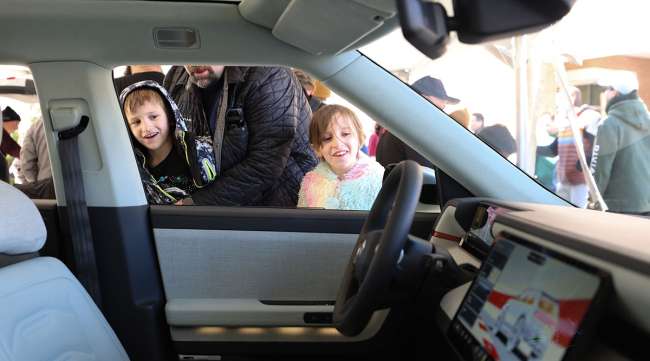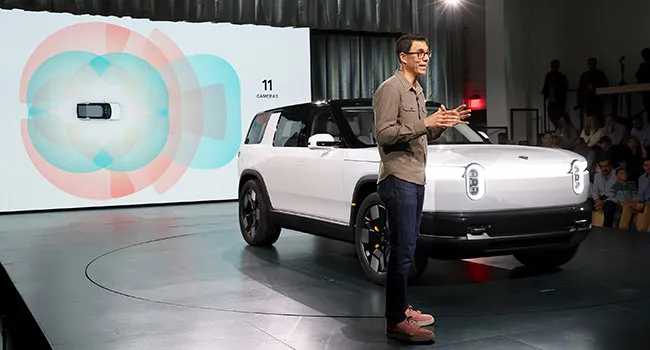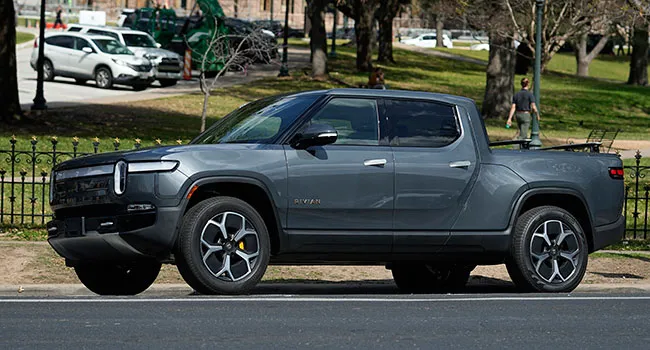Rivian Hosts R2 Event in Illinois at New Production Home

[Stay on top of transportation news: Get TTNews in your inbox.]
NORMAL, Ill. — Nearly five years after unveiling its prototype electric pickup truck and SUV for a Normal community looking to restart its idled auto plant, Rivian Automotive was back in town April 6 with its second-generation EVs and the promise of more activity at the now-bustling factory.
The low-key but festive event showcased the midsize R2 SUV, which will be built in Normal after Rivian delayed plans for a second plant in Georgia. The smaller and sportier R3 crossover, whose production plans have yet to be announced, was also on display.
Rivian revealed both new models last month while springing the news that the R2, at least initially, will be made in Illinois. The company received more than 68,000 preorders for the $45,000 R2 within 24 hours of its online debut.
“It not only allows us to save a lot of capital, it allows us to launch the vehicle sooner,” Rivian CEO R.J. Scaringe said at the event. “And based on the reaction to the product, it’s important we launch this as quickly as possible.”
Rivian builds its inaugural full-size electric R1T pickup truck, R1S SUV and commercial delivery vans for Amazon and AT&T in a renovated 4 million-square-foot auto plant on the outskirts of the college town about 130 miles south of Chicago.
The plant employs 7,000 assembly workers, up from zero after Mitsubishi closed the factory nearly a decade ago.
Scaringe purchased the shuttered factory for $16 million from a liquidation firm in January 2017. Boosted by more than $1 billion in investment and expansion, the plant has built more than 100,000 EVs since restarting production in 2021.
Rivian is expected to save more than $2.25 billion in capital expense by launching production of the R2 alongside the rest of its lineup in Normal and putting plans to build the $5 billion Georgia plant on hold, Scaringe said.
Rivian built nearly 14,000 EVs in the first quarter and is on target to produce 57,000 vehicles in Normal this year. None of them will be built over the next three weeks, however.
The plant shut down for retooling April 8 to streamline operations. When it reopens April 28, it will go from three shifts to two, with all assembly line workers expected to keep their jobs, albeit on different schedules.
“We are increasing the overall capacity and efficiency of our lines,” said Tim Fallon, 44, a former Nissan executive who has been vice president of manufacturing operations at the Normal plant since 2022. “Plus, we’re also making a lot of upgrades to our vehicles, many that you won’t see, but they help us with our costs.”
Fallon said the plant will come out of the shutdown operating at a higher line rate, which will enable it to still hit production targets for the year. The first major retooling since restarting the plant is not directly related to the future production of the R2, he said.

Rivian CEO R.J. Scaringe speaks during the Rivian Reveals All-Electric R2 Midsize SUV event March 7 in Laguna Beach, Calif. (Phillip Faraone/Getty Images for Rivian/TNS)
The R2 event comes as the rate of EV growth is beginning to slow, hindered by consumer concern about everything from range anxiety and charging infrastructure to sticker shock.
EV market share is expected to reach 8% of total new vehicle sales in 2024, up from 6.9% last year, according to the car shopping website Edmunds. EVs topped the 1 million sales mark in the U.S. last year for the first time.
Through February, EV sales totaled about 161,000 units, or 6.9% of the U.S. new car market, Edmunds said. That’s up 15% from the 140,000 EVs sold during the first two months last year, but far below the 64% growth rate from January 2022 to February 2022.
The slowing pace of EV adoption has caused a number of automakers — including Rivian — to adjust their course.
Market leader Tesla announced an 8.5% decline in EVs delivered in the first quarter and reportedly has abandoned plans to build a lower-priced Model 2 for the masses. Meanwhile, Ford said April 4 it would delay rolling out a new electric pickup and SUV until 2026 and 2027, respectively, as it adds gas-electric hybrids to its lineup, a growing trend in the industry.
In February, California-based Rivian laid off 10% of its salaried workforce, including a small number of employees at the Normal assembly plant.

Rivian's R1T pickup truck. (Associated Press/Eric Gay)
Rivian generated $1.3 billion in revenue and lost more than $1.5 billion in the fourth quarter of 2023. The company had $7.86 billion in cash as of Dec. 31.
But at $45,000 for the R2, Rivian may be in the sweet spot for an untapped EV demand. A study last month by Edmunds found that 47% of potential EV buyers are seeking to spend less than $40,000, while 42% want an SUV or crossover.
Last year, the average transaction price of an electric vehicle was $61,702, while all other vehicles stood at $47,450, Edmunds said. Rivian’s R1 models start at about $70,000.
“The R2 being at $45,000 is something that the vast majority of the population can look at as an option,” Scaringe said. “There’s a lack of choice, we believe, in that price category for really nicely done EVs.”

Scaringe
More than 3,000 people pre-registered for the four-hour event April 6, showing up at scheduled half-hour increments to afford an unhurried look at the new models.
Many circled around the R2, R3 and R3X prototypes in the open-air showroom, comparing notes, taking photos and in some cases, plunking down a $100 refundable deposit to reserve the first ones off the line in about two years.
Andrew Garcia, his wife and their two young daughters, who live in Normal, made their deposit after the online reveal last month and visited what they believe will be their first EV at the event.
Garcia, 32, said the midsize R2 fits their needs better than the R1, and by the time it goes into production, they will likely be ready to trade in their gas-powered Kia Telluride for a Rivian.
“We don’t have an electric, but we’ve been looking for an electric, and the R2 definitely fits the bill,” said Garcia. “We have to make a decision in 2026 when it rolls around, but as of right now, it looks very promising.”
Kyle Conner, 28, an EV YouTube content creator, drove 1,000 miles from his Fort Collins, Colo., home in a Tesla to get a close look and post videos of the new Rivian models. Conner, who also owns a Rivian R1, said the R2 will likely be a big hit despite a few reservations.
Among the many features that caught his eye, the R2 is the first Rivian built with a native port for the Tesla Supercharger network.
Last year, Tesla agreed to make its highly rated charging network accessible to Rivian and other manufacturers, enabling it to tap into $7.5 billion of federal funding from President Joe Biden’s bipartisan infrastructure law to expand public EV charging capacity.
Conner said the biggest selling point for the R2 was the $45,000 price tag. “What we don’t know yet are the final specifications,” he said.
During the event, the lanky, bespectacled Scaringe, his right arm in a sling from a mountain biking mishap, ambled through the crowd, casually greeting employees, customers and residents.
Reflecting on the open house five years ago, when he unveiled the first Rivian prototypes with little fanfare before the EV factory had been built, Scaringe, 41, thought about how far his auto company has come.
“I remember there were two cars — a truck and an SUV, early prototypes — and that was it,” Scaringe said. “And now there’s 100,000 vehicles on the road, and we’re cranking one of those out every couple of minutes. It’s pretty wild.”
Want more news? Listen to today's daily briefing below or go here for more info:
Distributed by Tribune Content Agency, LLC




